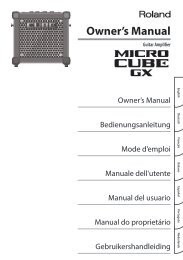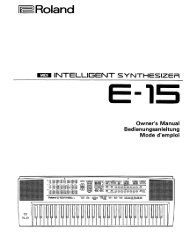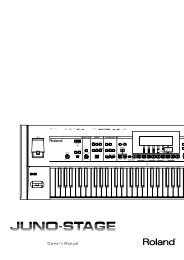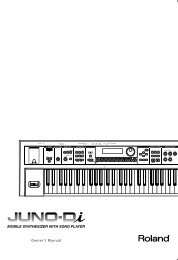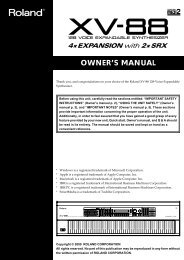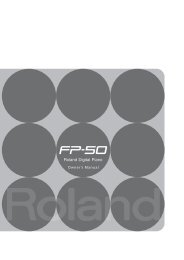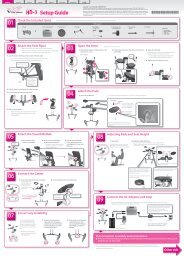You also want an ePaper? Increase the reach of your titles
YUMPU automatically turns print PDFs into web optimized ePapers that Google loves.
14. Phaser (Modulate the Sound)<br />
Chapter 4. Applying Effects to the Sound (Effects)<br />
By adding a phase-shifted sound to the original sound, this effect modulates the sound to add depth and a sense of rotation.<br />
Screen Parameter Explanation Value<br />
MANUAL Specifies the center frequency at which the sound will be modulated. 100 (Hz)–8.00 (kHz)<br />
DEPTH Specifies the depth of modulation. 0–127 Y<br />
RESONANCE This setting emphasizes the frequency range in the vicinity of the center<br />
frequency.<br />
RATE Specifies the frequency of modulation. If a note value or measure is<br />
selected as the value of this parameter, the Rate will synchronize with<br />
the BPM of the pattern at intervals of the specified note value or measure.<br />
MIX<br />
(Mix Level)<br />
Adjusts the proportion of the original sound that will be combined<br />
with the phase-shifted sound.<br />
* 1: 16 (16th note), 8T (8th note triplets), 16. (dotted 16th note), 8 (8th note), 4T (quarter note triplets), 8. (dotted 8th note), 4 (quarter note), 2T (half note<br />
triplets), 4. (dotted quarter note), 2 (half note), 1T (whole note triplets), 2. (dotted half note), 1 (whole note)<br />
* 2: 2M (2 measures), 3M (3 measures), 4M (4 measures), 8M (8 measures), 16M (16 measures)<br />
15. Chorus (Add Spaciousness and Depth to the Sound)<br />
This effect creates an impression of multiple sound sources in unison (Chorus effect), giving spaciousness and depth to the sound.<br />
* 1: 16 (16th note), 8T (8th note triplets), 16. (dotted 16th note), 8 (8th note), 4T (quarter note triplets), 8. (dotted 8th note), 4 (quarter note), 2T (half note<br />
triplets), 4. (dotted quarter note), 2 (half note), 1T (whole note triplets), 2. (dotted half note), 1 (whole note)<br />
* 2: 2M (2 measures), 3M (3 measures), 4M (4 measures), 8M (8 measures), 16M (16 measures)<br />
0–127<br />
0.1–10.0 (Hz), notes<br />
(*1), measures (*2)<br />
0–127<br />
OUTPUT PAN Specifies the stereo location of the output from the Phaser effect. L64–R63<br />
OUTPUT LEVEL Specifies the output volume of the Phaser effect. 0–127<br />
Screen Parameter Explanation Value<br />
PRE DELAY<br />
Specifies the time from the original sound until 0.0–100<br />
(Pre Delay Time) when the chorus sound is heard.<br />
DEPTH Specifies the depth of modulation. 0–127 Y<br />
PHASE Adjusts the spaciousness of the sound.As this<br />
setting is increased, the sound will spread more<br />
toward left and right.<br />
RATE Specifies the rate of modulation. If a note value<br />
or measure is selected as the value of this parameter,<br />
the Rate will synchronize with the BPM of<br />
the pattern at intervals of the specified note value<br />
or measure.<br />
FILTER TYPE Determines the type of filter that will be applied<br />
to the chorus sound.<br />
CUTOFF<br />
(Cutoff Frequency)<br />
BALANCE<br />
(Effect Balance)<br />
0–180<br />
0.1–10.0 (Hz), notes (*1), measures<br />
(*2)<br />
OFF (a filter will not be used),<br />
LPF (the frequency range above the<br />
cutoff frequency will be cut),<br />
HPF (the frequency range below the<br />
cutoff frequency will be cut)<br />
Specifies the cutoff frequency of the filter. 200 (Hz)–8.00 (kHz)<br />
Adjusts the volume balance between the original<br />
sound and the chorus sound.With a setting<br />
of “0,” no chorus sound will be output.<br />
OUTPUT LEVEL Specifies the output volume from the stereo chorus.<br />
0–100 (%)<br />
0–127<br />
X<br />
X<br />
51<br />
Chapter 4



